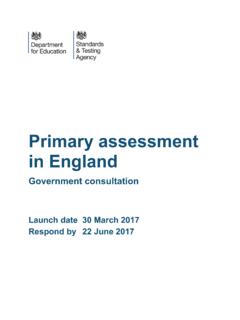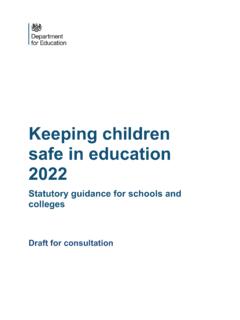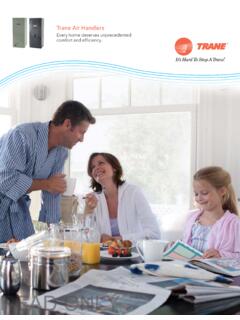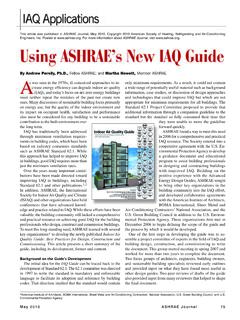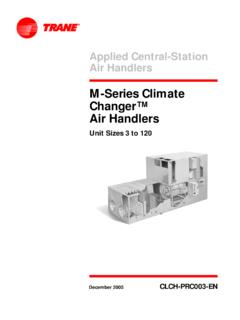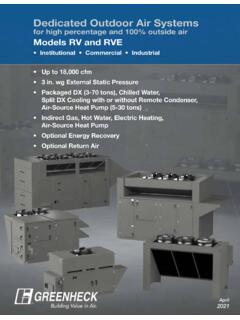Transcription of Guidelines on ventilation, thermal comfort and indoor air ...
1 Guidelines on ventilation, thermal comfort and indoor air quality in schools Building Bulletin 101 Draft for public consultation June 2016 2 Version control Version Amendments Author/reviewer Approved by Date V1: 06 05 2016 Draft for Public Consultation For consultation Richard Daniels Technical Manager, EFA Ann Bodkin Head of Design and Specification EFA 06/05/2106 3 Contents Version control 2 List of Figures 6 List of Tables 7 Summary 8 Acknowledgements 8 Disclaimer 8 Expiry/review date 8 Who is this advice for? 8 Key points 9 BB101 Advisory Group Members 9 Glossary 10 1 Introduction 11 indoor environmental quality 11 Ventilation strategy 13 2 Regulatory Framework 15 Building Regulations 15 Part F of the Building Regulations on Ventilation 15 Part L (AD L) on Conservation of Fuel and Power 15 Part C of the Building Regulations on site preparation and resistance to contaminants and moisture (including radon) 16 Areas covered by the English Building Regulations 17 Work on existing buildings 18 Health and safety legislation 18 Workplace and School Premises Regulations 19 DfE performance standards for teaching and learning spaces 21 Ventilation of practical spaces 22 Ventilation of other buildings and non-teaching spaces 25 Local extract ventilation 25 indoor air quality and ventilation 28 Location of ventilation air intakes and exhausts 28 4 Prevention of overheating in warmer weather 28 Gas safety regulations and standards 29 Carbon monoxide detectors in schools 32 3 indoor and outdoor air quality and thermal comfort 34 indoor and outdoor air quality Guidelines and UK air quality standards 34 indoor air pollutants 37 Sources of indoor pollutants 40 Minimising sources 41 indoor source control 41 Outdoor air pollutants and sources 44 Minimising ingress of polluted outdoor air into buildings 44 Filtration 46 Location of ventilation air
2 Intakes 47 Location of exhaust outlets 49 Biomass boiler flues 50 Building airtightness and thermal bridging 51 thermal comfort 51 Operative temperature range 55 Local thermal discomfort caused by draughts 59 Radiant temperature difference 61 Vertical temperature difference 63 Hot or cold feet caused by floor temperature 63 Performance standards for the avoidance of overheating 63 Assessment of performance in use 70 Performance in use standard for overheating 70 4 Design 72 Ventilation strategy 72 Natural ventilation 72 Design of natural ventilation openings 73 Design of stack ventilation and atria 73 Mechanical ventilation 75 5 The Coanda Effect 76 Control of ventilation 76 Control of cold draughts 77 Design to take into account the effect of wind and rain 77 Testing of dampers and weather louvres 78 Window design 78 thermal mass and night cooling 78 thermal mass and night purge 80 Energy efficiency 81 Climate change adaptation 81 Heating system selection, sizing and control 82 Life cycle and maintenance 83 Acoustic standards 83 indoor ambient noise levels (IANL) 84 5 Design calculations 85 Weather File 85 Mechanical ventilation 86 Internal conditions 86 Internal gains 86 Ventilation opening areas 87 Annex A: Carbon dioxide levels in schools 90 Annex B.
3 indoor air pollutants, sources and health effects 95 Annex C. Guidance on construction products and materials in school buildings 101 References 103 6 List of Figures Figure The environmental circle .. 11 Figure Types of ventilation system .. 14 Figure Examples of problematic flow patterns in a three storey atrium building .. 73 Figure Definition of the atrium enhancement metric .. 74 Figure Ideal design blueprint for an atrium building.. 75 Figure Example of ventilation area reduced by the protrusion of the window sill. In the example above top hung windows are opened by the same stroke length, s, but the protruding sill impacts on the free area because a<b .. 89 Figure Example of ventilation area reduced by the restrictor. Column prevents window opening .. 89 Figure Typical changes in CO2 levels with demand controlled room-based mechanical ventilation systems, Graph provided by SAV Airmaster .. 91 Figure Average occupied CO2 concentration in February, for a secondary maths classroom in a school in the North West of England.
4 Graphs provided by SE Controls .. 92 Figure Average occupied CO2 concentration in July, for a secondary maths classroom in a school in the North West of England. Graphs provided by SE Controls .. 92 Figure A Secondary School all year CO2 monitored results. Graph provided by Breathing Buildings .. 93 Figure A Preparatory School for age up to 13 years wintertime CO2 levels monitored. Graph provided by Breathing Buildings .. 93 7 List of Tables Table Minimum exhaust rates to be provided in science and practical spaces.. 23 Table WHO indoor air quality Guidelines and UK ambient air quality objectives .. 36 Table SINPHONIE indicators for IAQ monitoring in European schools (Kephalopoulos et al., 2014) .. 37 Table Typical sources of indoor air pollutants in school buildings .. 41 Table Building materials, product labels on chemical emissions in EU .. 43 Table Recommended minimum filter classes per filter section (definition of filter classes according to EN 779) .. 47 Table Guidance on ventilation intake placement for minimising ingress of pollutants (Derived from Table of Approved Document F).
5 48 Table Categories of building .. 53 Table Category and PPD and PMV .. 53 Table comfort categories for schools for specific environmental criteria .. 54 Table Recommended operative temperatures during the heating season measured at from the floor in the centre of the room .. 57 Table indoor air pollutants, sources and health effects .. 95 8 Summary This document sets out regulations, standards and guidance on ventilation, thermal comfort and indoor air quality for school buildings. It replaces Building Bulletin 101, Ventilation of School Buildings , 2006. Section 1 provides an introduction and describes the factors that affect the design of the indoor environment of schools. Section 2 describes the regulatory framework for schools. It gives the recommended DfE performance standards for compliance with UK regulations. Sections 3 to 5 provide detailed guidance on how to design schools to achieve the required performance for ventilation indoor air quality and thermal comfort .
6 Acknowledgements DfE would like to thank the members of the advisory group listed below, and the organisations: Public Health England, the Health and Safety Executive, the Institution of Gas Engineers and Managers (IGEM), CLEAPSS, the Design and Technology Association (DATA), the Chartered Institution of Building Services Engineers (CIBSE) and the Institute of Local Exhaust Ventilation (ILEV) for their help in drafting this document. Disclaimer DfE and its advisers accept no liability whatsoever for any expense, liability, loss, claim or proceedings arising from reliance placed upon this document. Expiry/review date This advice will next be reviewed in 2021. Who is this advice for? This advice is for those involved in the design, specification and construction of school buildings. 9 Key points The objective is to provide guidance on the design and construction of school buildings in order to provide good indoor air quality and thermal conditions that enable effective teaching and learning.
7 BB101 Advisory Group Members Malcolm Cook, Loughborough University Alan Fogarty, Cundall Hershil Patel, Jacobs Peter Dyment, Camfil Lars Fabricius, SAV David Bradbury, SAV Malcolm Orme, AECOM James Vaux Anderson, Bowmer and Kirkland Azadeh Montazami, Coventry University Shaun Fitzgerald, Breathing Buildings and Cambridge University Sani Dimitroulopoulou, Public Health England Chris Iddon, SE Controls Peter Henshaw, Buro Happold Paul Sperring, Cundall Jackie Maginnis, Modular and Portable Buildings Association Gary Morgan, Eco-Airvent Ricardas Ruikis, Airflow Developments James Hammick, Passivent Nick Hopper, Monodraught Peter Dyment, Camfil Keeran Jugdoyal, Faithful and Gould Andrew Spencer, EFA Engineering Design Adviser Benjamin Jones, University of Nottingham Jannick Roth, Windowmaster Barrie Church, IGEM Dominic Cropper, Arup Mike Entwistle, Buro Happold Ken Bromley, DCLG Craig Wheatley, IES Paul Keepins, Welsh Government Matt Endean, CLEAPSS Dave Parry, CLEAPSS Phillip Wild, IGEM, CoGDEM, Duomo James Wheeler, HSE Wally Gilder, ILEV 10 Glossary For definitions of building services terms such as radiant temperature, see CIBSE Guide A.
8 Natural ventilation is defined as ventilation where the driving force is buoyancy or wind. Mechanical ventilation is defined as ventilation where the driving force is provided by a fan. Mixed mode and hybrid ventilation are terms used to define ventilation that combines or switches between natural and mechanical ventilation and / or cooling systems1. Where the term average is used in this document, it means arithmetic mean. Kelvin is the absolute temperature scale, ie, 20oC = 293 K Operative temperature is sometimes known as dry resultant temperature ; it takes account of the mean radiant temperature of the surfaces in the room and the air temperature in the room. PPD Percentage people dissatisfied is used in comfort criteria. PMV Predicted mean vote is also used in comfort criteria. The working definition of overheating adopted by BB101 (Building Bulletin) is derived from that2 developed by the Zero Carbon Hub for homes and is: The phenomenon of excessive or prolonged high temperatures, resulting from internal or external heat gains, which may have adverse effects on comfort , health or learning activities 1 CIBSE AM10 gives more information on mechanical, natural, hybrid and mixed mode ventilation.
9 2 Overheating in homes the big picture 11 1 Introduction indoor environmental quality This Building Bulletin describes the environmental factors that affect ventilation. It describes the regulations that apply in Section 2, on page 15. These Guidelines are aligned with the latest drafts of BS EN 15251 indoor environmental inputs for design and assessment of energy performance in buildings addressing indoor air quality , thermal environment, lighting and acoustics and BS EN 13779 Ventilation for non-residential buildings Performance requirements for ventilation and room-conditioning systems and international comfort standards ISO 7730: 2005 and PD CR 1752: 1999 CEN Technical Report Ventilation for buildings Design criteria for the indoor environment . Ventilation is a key part of holistic design for indoor environmental quality (IEQ). The Environmental circle below describes the environmental design factors3 that need to be addressed and the potential conflicts between the factors that need to be resolved4.
10 Figure The environmental circle Building Bulletin 93 Acoustic Design of Schools: Performance Standards, Department for Education, 2015 and the IoA/ANC Acoustics of Schools: a design guide, November 2015 give the design criteria for acoustics. 3 The environmental circle is described in the paper A comprehensive review of environmental design in UK schools: History conflicts and solutions by Azadeh Montazami (Coventry University), Mark Gaterell (University of Portsmouth) and Fergus Nicol (London Metropolitan University, London). 4 See CIBSE TM57 for a discussion of some of the design conflicts and ideas to resolve them. 12 CIBSE Lighting Guide LG5, Lighting in Education gives the criteria for lighting design in schools. The EFA (Education Funding Agency) daylight and lighting systems design guide and the EFA Window and Door design guide provide further guidance. Design for IEQ is the basis of BS EN 15251. A holistic multi-disciplinary approach is needed to prevent unintended consequences of design driven by low energy or other overarching design drivers5.

